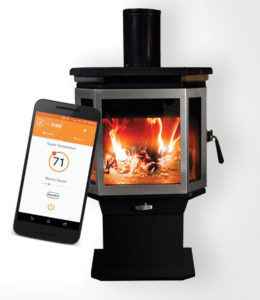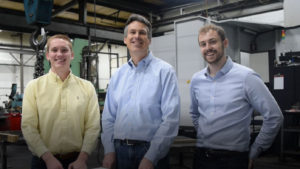
Frederick County Native Helps Create Clean-Burning Wood Stove
James Rada
 Imagine having a wood stove where all you needed to do was add wood and throw in a match? The stove would then take things from there, getting the fire going and keeping the room where the stove is located at just the right temperature, as well as burning the wood so efficiently that there is only a tiny amount of ash left.
Imagine having a wood stove where all you needed to do was add wood and throw in a match? The stove would then take things from there, getting the fire going and keeping the room where the stove is located at just the right temperature, as well as burning the wood so efficiently that there is only a tiny amount of ash left.
“We call our stove the Catalyst,” said Taylor Myers, a Catoctin High graduate and chief technical officer for MF Fire. “It’s the first automated wood stove. It uses a smart controller and automatically adjusts to optimize efficiency and cleanliness, and it’s easy to use.”
Myers and his business partner, Ryan Fisher, developed the idea for the Catalyst while they were attending University of Maryland College Park in the fall of 2012. Myers was studying fire protection engineering and decided to compete in the Alliance for Green Heat’s Wood Stove Decathlon that was held in Washington D. C. He and his partner put together a prototype of the Catalyst they called the Mulciber. They were the only student team competing in the Wood Stove Decathlon in 2013.
“We won the low-emission prize, and then the next year we won the grand prize,” said Myers.
After that success, Myers and Fisher knew they were onto something and needed to bring the stove to market. They teamed up with Paul LaPorte to develop a commercial model of the stove and create MF Fire.
The Catalyst can heat 2,000 square feet using standard cord wood, and it is a free-standing stove that can replace any existing stove. Future improvements might include a fireplace insert as well.
“New regulations are going to make 85 percent of the wood stoves on the market now illegal to sell after January 2020, but we’re already compliant with those new regulations,” stated Myers.
Testing showed that the Catalyst has only 0.2 gm per hour of particulate emissions, which is twenty times lower than the new EPA rules require. The Catalyst has a 99.5 percent combustion efficiency, which means that nearly all of the wood is consumed. This creates less smoke.
“We generate less than half the smoke of one cigarette,” explained Myers.
It also releases 30 percent less carbon dioxide than a traditional wood stove.
The Catalyst can be controlled from a computer or smartphone. You can remotely start your stove and have a warm house to come into after being outside.
“You load the wood in the stove, throw in a match, set the room temperature on your smartphone, and the stove takes care of the rest,” said Myers.
Although the company’s offices are in Baltimore, the stoves are manufactured in Smithsburg.
The U.S. Census estimates that 2.5 million homes heat with wood stoves, and the Catalyst may make the option attractive to even more households.
The first shipment of the Catalyst stoves is preparing to ship to customers who paid just under $5,000 for them.
To learn more about this new way to heat your home, visit the website at mffire.com.

Pictured from left to right are Ryan Fisher, Paul LaPorte, and Taylor Myers
